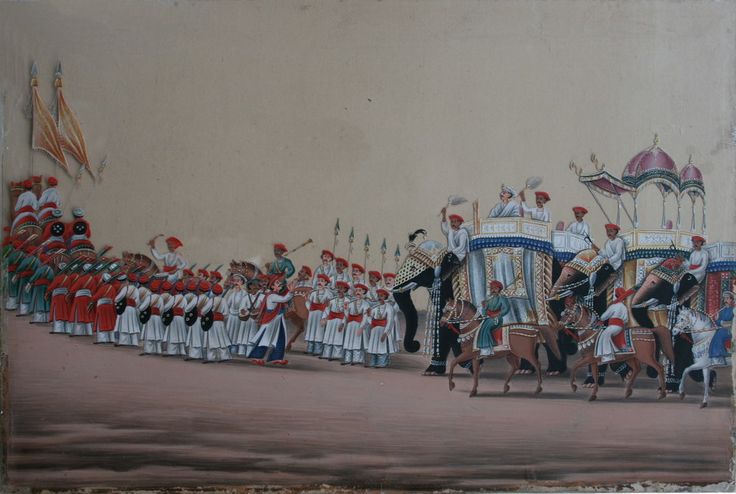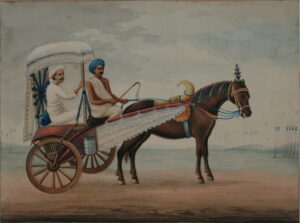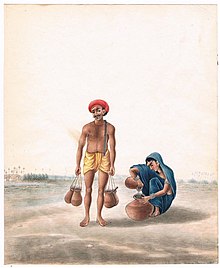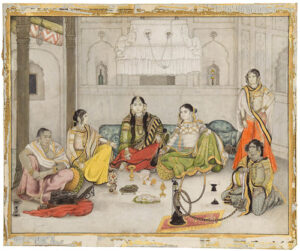Patna Kalam: Bihar’s adrift artform

Patna Kalam painting, also known as Company painting or Patna School of painting, was one of the schools which were an offshoot of Mughal paintings
The eastern state of Bihar is known for its highly stylised Mithila and Madhubani painting traditions. But very few are aware of an equally popular folk-based school of painting, which has survived in the region for more than 200 years – the Patna Kalam.
“Once very popular in the state, Patna Kalam paintings are now just limited to the walls of some museums, colleges and libraries. Of late, Patna Kalam, a school of painting and an amalgamation of Mughal painting and British school of painting, has lost its sheen,” Shyam Sharma, principal of College of Arts and Crafts, Patna, tells Media India Group.
A yellowish framed canvas has small, colourful motifs of a water seller sitting beside a potter and a tonga (horse-cart) parked nearby, while the golden, sun rays fall on them, sitting by a muddy road. There is nothing to be seen in the background, except for empty space. Below the frame, a metallic plate reads “A Firka, made with Kajli seahi (black ink); Artist: Ishwari Prasad Verma.”
This is a popular 19th century Patna Kalam painting adorning a small corner of the wall in painting gallery of Patna Museum.
Patna Kalam painting, also known as Company painting or Patna School of painting, was one of the schools which were an offshoot of Mughal paintings that flourished during the early 18th to the mid-20th century in Bihar.
“With the decline and subsequent fall of Murshidabad, the court artists looked westwards to the next biggest city in the East and started migrating to Patna. By 1750s, many of those artists had settled in Patna with their families, and under the patronage of local aristocracy and often Indophile scions of early East India, started a unique form of painting which came to be known as the Company School or Patna Kalam,” explains Sharma.
Most of the paintings are miniatures made on paper. Later on, drawing on ivory and leather also became popular. Paintings on daily life are in abundance in this style. Daily labourer, fish-sellers, basket makers dominate the subject of these paintings. Patnia Ekka (horse-cart of Patna) is one of the oldest surviving paintings, still present in Patna museum. Artist Shivlala’s Muslim Wedding, Gopal Lal’s Holi, Mahadev Lal’s Rani Gandhati are some of the others that have survived the test of time.
“In this style of painting, colours are extracted from indigenous plants, barks, flowers and metals. Paintings are characterized by light coloured sketches and life-like representations,” adds Sharma.
One of the important characteristics of Patna Kalam is that usually, they do not paint any landscape, foreground or background. Another unique feature of the Patna School of Painting was the development in the shading of solid forms. Paintings are painted straightway with a brush without using a pencil to outline the contours of the picture. This technique was commonly known as Kajli Seahi.

The Patna Kalam paintings are currently exhibited in different museums of Britain and in possession of private buyers
“Unlike the rich and opulent Mughal miniatures, the Patna Kalam painters abstained from painting the royalty and rather concentrated on the daily life of India as it was back then. The subjects are really very simple depictions of the sets of caste occupation known Firka (revenue circle). The contents of Firkas were based on common everyday life like the washerman, butler returning from the market, tailor, sweeper, a servant struggling with a dog and many more,” explains Sharma.
Sharma, who has also authored a book titled Patna Kalam, adds “The Britishers used to buy the paintings as a souvenir from Patna. These paintings would familiarise foreigners with the lifestyle of people here. The masterpieces of this art form are outside the country.”
The Patna Kalam paintings are currently exhibited in different museums of Britain and in possession of private buyers, many of them foreigners. Art enthusiasts of the city can only get a glimpse of them at places like Patna Museum, College of Arts and Crafts Patna and Khuda Baksh Oriental Public Library.
“The speciality of this painting was its simplicity. The day-to-day chores of normal people were brought down on the canvas in a unique way. To woo the British, the painters had imbibed the European style of painting. The paintings were painted generally in a miniature format on handmade paper, bamboo sheets, ivory and mica and the colours used in the paintings were extracted from indigenously from flowers, leaves, petals and plant barks. The paintings were made straight away with a brush, without outlining the structure of the creatures,” says Sharma.
Manoj Kumar Bachhan, who has made a documentary on Patna Kalam, says that completing the painting is a daunting task. “The painter and their family would work throughout the year to arrange colours, brushes and papers,” Bachhan says, adding while summer was the ideal time to make colours, the painters used to apply the colours on the paintings during winters.
The book authored by Sharma mentions of some celebrated painters of Patna Kalam that includes Sewak Ram (1770-1830), Hulas Lal (1785-1875), Jairam Das, Fakir Chand, Jhumak Lal, Nityanand Lal, Tunni Lal, Shiv Lal, Shiva Lal, Mahadeo Lal, Shyam Bihari Lal and so forth. Commenting on their styles, it reads “Nisar Mehdi was prominent for representations and scenes, while Hulas Lal utilised his naturalistic figures as the material for a natural beat.”
The last painters of this art form were Ishwari Prasad Verma and Radha Mohan Babu, who was also the founder of Patna Art School, now famously known as College of Arts and Crafts.
The Patna School of Painting is facing a gradual decline and becoming a matter of past with the lapse of time as new faces are not coming forward to carry on this ancient tradition and the old ones are passing away one by one.
Citing the reasons behind the extinction of the painting style, he says “The school has died because of lack of demand after the departure of Britishers from the country. Also, earlier, kings and rulers used to give the painters patronage, which is not possible now. The invention of cameras has also contributed to the downfall of it.”
The government of Bihar has also done little to revive this art-form, says Bachhan, “By making their 2010 calendar as a series of Patna Kalam paintings, the government of Bihar had, for the first time since independence, paid attention to this 250-year-old school of miniature paintings, however, I have not witnessed any other noticeable effort being made after that,” he adds.
“Lost art forms like the Patna Kalam are a testament to sustainable and simple practices too. This style combined elements of the Mughal and British styles of paintings so well, that some people also called it the Firangee Kalam (the White man’s art), however, due to negligence of our own people and the state government, it has become something that only foreign galleries are decorated with and foreign researchers research about,” says Bachhan.











